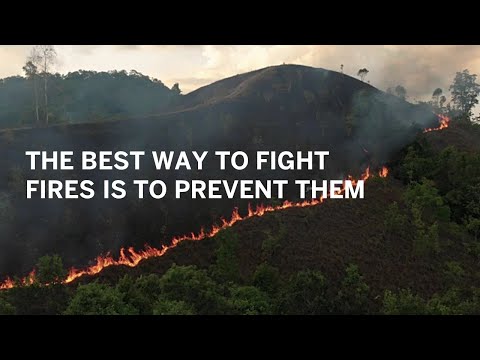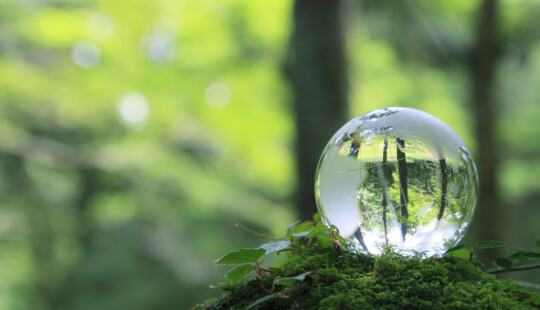“There’s nothing more terrifying than a wall of fire advancing across your backyard,” says Ronnie Gibson, a volunteer firefighter in the Brazilian state of Minas Gerais. “I was completely caught off guard by a fire in my neighborhood 12 years ago. The fire approached at an alarming rate and razed my house. That was my call to action. I realized the community was totally unprepared to deal with such forces of nature.”
Community Centered
Today, Gibson is at the forefront of firefighting activities in a subtropical place where the summers are typically long, hot, and humid. In this part of Brazil, fires have been increasing in frequency and intensity due to changes to the climate and in agricultural practices. Gibson is a member of Brigada Carcará, a volunteer organization working in alignment with the local municipal firefighting agencies to protect the environment through the prevention and control of forest fires.
“A lot of our work revolves around educating people about the need for an ecologically balanced environment,” he explains. “We also provide support to communities and wildlife affected by natural and environmental disasters.”

The best way to fight fires is to prevent them from breaking out in the first place. That requires round-the-clock vigilance, especially during hot, dry periods. Early detection is critical. A forest fire usually begins when grass and dry undergrowth are ignited, generating a ground fire, which is easy to control. If it grows into a wildfire, it can leap into the treetops, leading to a crown or canopy fire where the flames spread rapidly. Crown fires are considerably more difficult to control and can easily grow into a conflagration, which is practically impossible to extinguish.
Fires break out on a monthly basis even during the rainy season. There is a constant struggle for resources, manpower, and equipment. Gibson’s goal is to hire a few full-time workers because, as passionate as they may be, volunteers have day jobs and other obligations, making it difficult for them to drop everything whenever a fire breaks out.
“If we get there in the first 10 minutes, we can usually nip a fire in the bud before it spreads. After 15 or 20 minutes, it’ll be impossible to control. So, early warning is critical,” he says.
But it’s not just about sending people out to the fire. The group needs someone to man the phone at all hours, as more and more requests are coming in. He himself is constantly monitoring a vast territory on his laptop. Besides being passionate, volunteers must be flexible in order to respond to sudden calls. His team of four includes a yoga teacher, an artist, a carpenter, and a gardener, people who can drop the tools of their trade to dash out on a call.
The hours are long; volunteers come home tired and dirty. The day doesn’t end after the fight. “I used to spend hours collating the data – location, territory covered, number of people involved, type of vegetation burned, resources used. Every detail needs to be recorded. In the meantime, I’d be doing my laundry and preparing my equipment for the next day,” says Gibson, describing his daily tasks.
Data Based
When it comes to data, though, things have gotten better. A dedicated team at SAP Brazil developed a geo-referencing, image recording, and real-time data platform that’s helping Brigada Carcará fight forest fires, rescue bees, and plant trees in a broad reforestation program.
“The platform helped us modernize our entire service structure and enables us to generate the essential data for monitoring and analyzing occurrences in real-time,” says Marcio Amorim, co-founder of the non-profit organization dedicated to protecting people, wildlife, and nature.
“We’re experiencing a completely new reality thanks to the technology. Previously, we relied totally on the manual input of data, which led to errors and was not providing the visibility needed for preventive action. We were using outdated maps. Now, we’re tracking and tracing everything using GPS coordinates on our mobile devices. We can capture images of the damage, measure the impacted territory, and identify the species and number of animals killed and wounded.”
Based on SAP Business Technology Platform (SAP BTP) and SAP HANA, the application enables Brigada Carcará to achieve three goals:
- Prevent forest fires through improved monitoring capabilities and relevant data analysis.
- Salvage and reestablish apiaries in partnership with Cresan, a local NGO dedicated to preserving and protecting the 130 species of native bees throughout the region.
- Revive and replant forests impacted by fires – tasks include analysis of charred lands and tree remnants and the management of nurseries for growing native species for reforestation.
Whereas some of the analytical tasks may have taken several days to complete, now they are done in a matter of minutes.
Future Focused
Pif Paf, a leading Brazilian producer of meat and poultry, and Grupo LPJ, the SAP implementation partner that got the application up and running, were keen to help SAP develop the application.
Like SAP, whose purpose is to run better and improve people’s lives, these companies are equally focused on improving life for people and the planet. Pif Paf has its own recipe for maintaining continuous sustenance in the world’s fifth largest country. A member of the Global Compact, with over 1,000 food products for national and international consumption, the company has been a leader in the humane handling of animals on farms and their journey to slaughter.
At the forefront of the fight against forest fires since 2014, Brigada Carcará was called out a total of 310 times since 2020, playing a prominent role in protecting the region’s natural and cultural heritage.
“Thanks to the SAP application, we are much better prepared,” says Gibson. “We’re also able to exchange data and best practices with other parts of the country and even other countries like Portugal that are suffering from extreme conditions conducive to forest fires.”
For nature and communities, whichever way you look at it, it’s a win-win for all.



